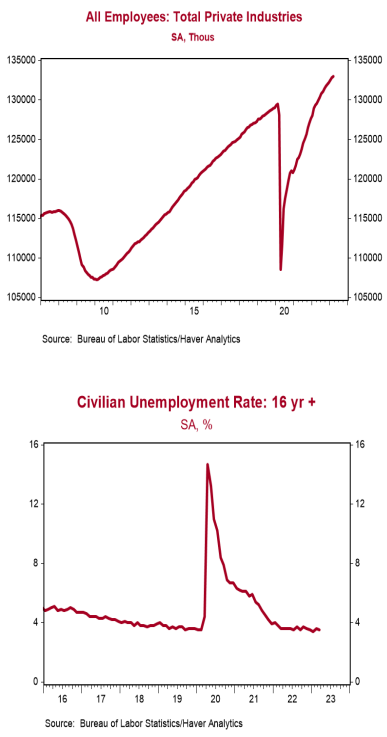- Nonfarm payrolls increased 236,000 in March, very close to the consensus expected 230,000. Payroll gains for January and February were revised down by a total of 17,000, bringing the net gain, including revisions, to 219,000.
- Private sector payrolls rose 189,000 in March and were revised down 32,000 in prior months. The largest increases in March were for leisure & hospitality (+72,000), education & health services (+65,000), and professional & business services (+39,000, including temps). Manufacturing declined 1,000 while government rose 47,000.
- The unemployment rate ticked down to 3.5% from 3.6% in February.
- Average hourly earnings – cash earnings, excluding irregular bonuses/commissions and fringe benefits – rose 0.3% in March and are up 4.2% versus a year ago. Aggregate hours declined 0.1% in March but are up 2.0% from a year ago.
Implications: The labor market put in a mediocre performance in March in spite of headlines to the contrary. Those headlines include an increase in nonfarm payrolls of 236,000 and a tick down in the unemployment rate to 3.5%. In addition, civilian employment, an alternative measure of jobs that includes small business start-ups, increased 577,000 for the month. That rise in employment was accompanied by a 480,000 increase in the labor force – people who are either working or looking for work – pushing up the participation rate to 62.6%, the highest since March 2020 and the onset of COVID. If that were all the data we had, we’d walk away feeling very good about the job market. But that’s not all the data. Even as the number of people working went up, the total number of hours worked slipped 0.1%. In other words, businesses were hiring but there was less for their workers to do. In turn, this is consistent with our view that the labor market will be a lagging indicator as we enter the next recession; businesses will keep hiring because they think they need to hoard workers to fulfill future increases in business activity. But if those increases don’t come, that just means more workers who get laid off later on. Some key sectors are already showing weakness, with manufacturing losing jobs for the second straight month and construction losing jobs for the first time in more than a year. Average hourly earnings rose a respectable 0.3% in March but are up 4.2% in the past year, not enough to keep up with inflation. At this point in the business cycle it’s important to separate two different angles on the labor market: the level versus the direction. The level of the labor market is strong: unemployment is low, businesses are still hiring, and it’s relatively easy to get a job. However, improvements in the labor market have slowed down from a year ago and we expect that trend to intensify to the point where jobs are declining and unemployment rising later this year. In other recent news on the labor market, initial claims for jobless benefits fell 18,000 last week to 228,000. Continuing claims rose 6,000 to 1.823 million. However, the big story is that both these series were revised up substantially for the past several months. An economic storm is gathering and the labor market won’t be immune.





